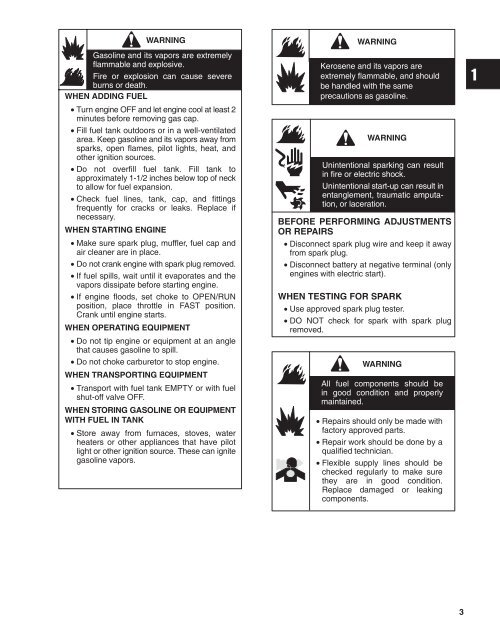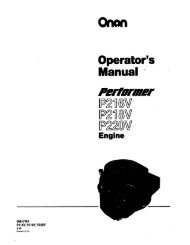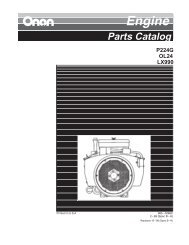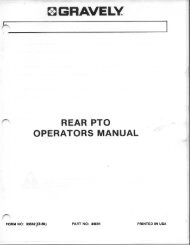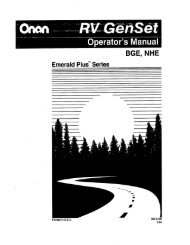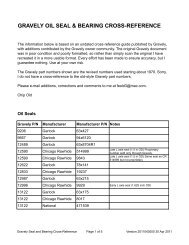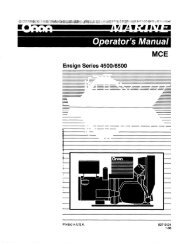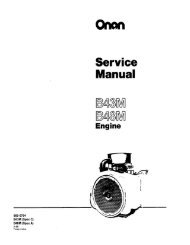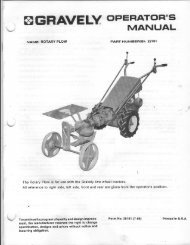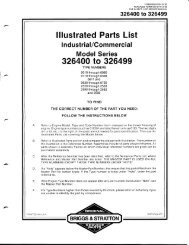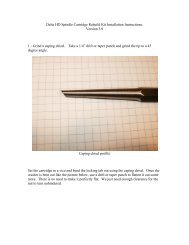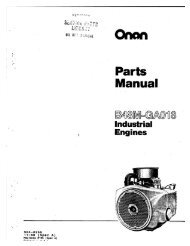272144 Vanguard Twin Cylinder OHV BRIGGS & STRATTON.pdf
272144 Vanguard Twin Cylinder OHV BRIGGS & STRATTON.pdf
272144 Vanguard Twin Cylinder OHV BRIGGS & STRATTON.pdf
You also want an ePaper? Increase the reach of your titles
YUMPU automatically turns print PDFs into web optimized ePapers that Google loves.
WARNING<br />
Gasoline and its vapors are extremely<br />
flammable and explosive.<br />
Fire or explosion can cause severe<br />
burns or death.<br />
WHEN ADDING FUEL<br />
• Turn engine OFF and let engine cool at least 2<br />
minutes before removing gas cap.<br />
• Fill fuel tank outdoors or in a well-ventilated<br />
area. Keep gasoline and its vapors away from<br />
sparks, open flames, pilot lights, heat, and<br />
other ignition sources.<br />
• Do not overfill fuel tank. Fill tank to<br />
approximately 1-1/2 inches below top of neck<br />
to allow for fuel expansion.<br />
• Check fuel lines, tank, cap, and fittings<br />
frequently for cracks or leaks. Replace if<br />
necessary.<br />
WHEN STARTING ENGINE<br />
• Make sure spark plug, muffler, fuel cap and<br />
air cleaner are in place.<br />
• Do not crank engine with spark plug removed.<br />
• If fuel spills, wait until it evaporates and the<br />
vapors dissipate before starting engine.<br />
• If engine floods, set choke to OPEN/RUN<br />
position, place throttle in FAST position.<br />
Crank until engine starts.<br />
WHEN OPERATING EQUIPMENT<br />
• Do not tip engine or equipment at an angle<br />
that causes gasoline to spill.<br />
• Do not choke carburetor to stop engine.<br />
WHEN TRANSPORTING EQUIPMENT<br />
• Transport with fuel tank EMPTY or with fuel<br />
shut-off valve OFF.<br />
WHEN STORING GASOLINE OR EQUIPMENT<br />
WITH FUEL IN TANK<br />
• Store away from furnaces, stoves, water<br />
heaters or other appliances that have pilot<br />
light or other ignition source. These can ignite<br />
gasoline vapors.<br />
WARNING<br />
Kerosene and its vapors are<br />
extremely flammable, and should<br />
be handled with the same<br />
precautions as gasoline.<br />
WARNING<br />
Unintentional sparking can result<br />
in fire or electric shock.<br />
Unintentional start-up can result in<br />
entanglement, traumatic amputation,<br />
or laceration.<br />
BEFORE PERFORMING ADJUSTMENTS<br />
OR REPAIRS<br />
• Disconnect spark plug wire and keep it away<br />
from spark plug.<br />
• Disconnect battery at negative terminal (only<br />
engines with electric start).<br />
WHEN TESTING FOR SPARK<br />
• Use approved spark plug tester.<br />
• DO NOT check for spark with spark plug<br />
removed.<br />
WARNING<br />
All fuel components should be<br />
in good condition and properly<br />
maintained.<br />
• Repairs should only be made with<br />
factory approved parts.<br />
• Repair work should be done by a<br />
qualified technician.<br />
• Flexible supply lines should be<br />
checked regularly to make sure<br />
they are in good condition.<br />
Replace damaged or leaking<br />
components.<br />
3


